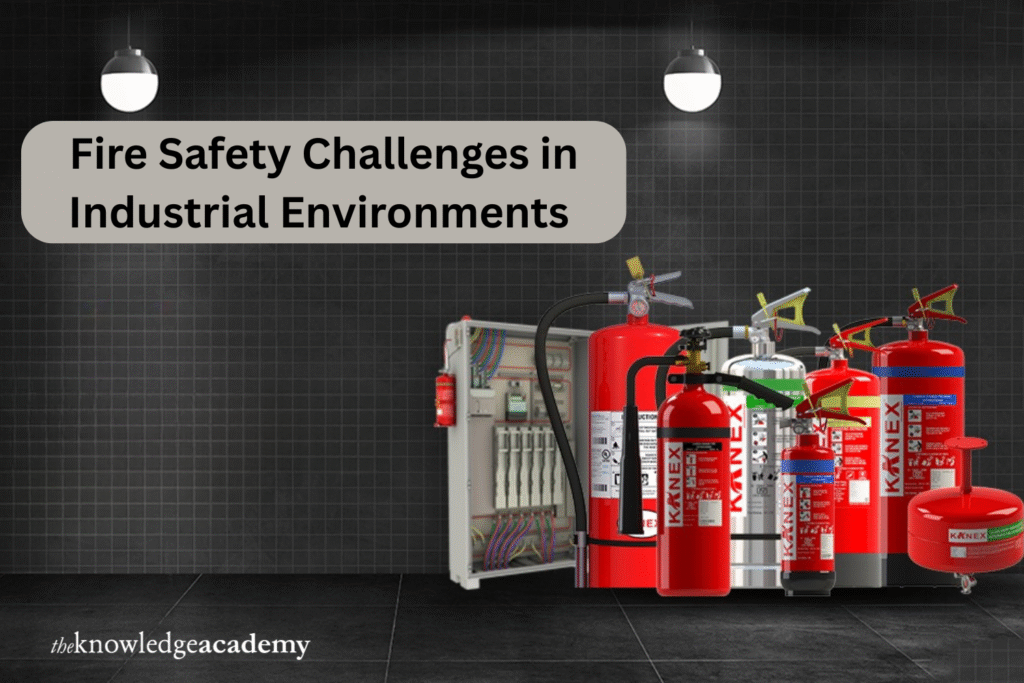How safe is your factory when heat, power and chemicals share one floor? Work moves fast and small lapses bring risks. This is where Fire Safety Training matters. It builds habits and turns quick thinking into safe action. Many still ask What is Fire Safety. It means spotting hazards early, controlling ignition and responding calmly.
This blog shares practical fixes. We explain why industrial Fire Safety needs more than basic checks and outline common challenges. It also provides simple ways to overcome them through training, risk checks, technology, drills, housekeeping, and maintenance.
Table of Contents
- Why Industrial Fire Safety Needs More Than Routine Checks
- Top Fire Safety Challenges in Industrial Environments
- Overcoming Fire Safety Challenges in Industrial Environments
- Conclusion
Why Industrial Fire Safety Needs More Than Routine Checks
Industrial sites change every day. New jobs start. Storage shifts. Machines wear. This is why industrial Fire Safety must be active, not passive. Routine checks help, yet they are not enough. You need live awareness on the shop floor. Keep records clear and simple. Walk the site often. Speak with operators. Small issues like stray packaging or warm cables can start a large event. Treat workplace safety as a shared duty, not a checklist task.
Top Fire Safety Challenges in Industrial Environments
Some risks hide in plain sight. Others grow slowly with poor habits. Watch out for these traps that hold back fire prevention.
- Overloaded circuits and poor cable care raise the chance of sparks and heat
- Flammable liquids near hot work speed up fire spread
- Blocked doors and narrow passages slow down escape
- Dust, lint, and offcuts collect and burn fast
- Confusing alarms and mixed messages create delays
- Tired kit and missed services weaken protection
- Contractors may not know the site rules and create gaps in health and safety
Overcoming Fire Safety Challenges in Industrial Environments
Factories have high fire risk because of machines, chemicals and power. To manage this, use awareness, clear plans and simple steps. Here are the next steps we will cover:
Stronger Teams Through Fire Safety Training
People save people. Tools help, yet people act. Regular and short Fire Safety training builds memory and confidence. Keep it in your hands. Let teams use fire extinguishers on safe practice rigs. Show how to pull the pin and sweep the base of flames. Run quick quizzes on alarm tones and the nearest exit. Rotate fire warden roles so more team gain skills. Record who joined and what they learned. Link training to real tasks so lessons stick.
Smart Controls and Fire Risk Assessment That Work
A good fire risk assessment is a living document. Start simple. Identify fuel, heat and oxygen. Note who could be harmed. Check current controls and decide what else is needed. Write short actions and assign an owner and a date. Review after layout or process changes. Store flammables in cages. Get spill kits ready. Use metal bins with tight lids for oily rags. Strong controls cut risk and support compliance with Fire Safety regulations.
Using Technology and Fire Alarm Systems for Safer Workplaces
Modern tools spot trouble early. Heat sensors watch bearings and panels. Smart alarms pinpoint zones in seconds. Linked sprinklers contain heat fast. Thermal cameras track hot spots on conveyors and silos. Simple tools matter too. Fit clear break glass points. Test sounders by zone so team recognizes them. Keep logs of tests and servicing. Technology plus routine checks lifts industrial Fire Safety.
Evacuation and Emergency Response Plan: People Remember
Plans work only if people remember them under stress. Keep the evacuation plan short and visual. Mark exits, routes and assembly points clearly. Assign marshals with backups. Practice brief drills across all shifts, time them and fix delays. Use simple phrases for alarm raised and area clear. Keep grab bags with radios, high visibility vests and site maps.
Handling Hazardous Materials Without Confusion
Many sites use chemicals or compressed gases. Store them by type. Keep bonding and earthing where liquids are filled or mixed. Use anti-static tools when needed. Label containers in large print. Train team to follow safety data sheets. Keep spill kits near use points. Ventilate rooms that handle vapor. Remove waste on a set schedule. Clear, visual rules help teams comply.
Good Housekeeping That Reduces Ignition
Clean floors and tidy racks cut fuel and fire paths. Set short daily tasks. Clear dust from cable trays and switch rooms. Empty bins early. Keep aisles wide and clear. Store hot work tools in metal units after use. Fix small leaks at once. Place no-smoking signs near fuel stores. Good housekeeping is a low-cost way to lift workplace safety every day.
Maintenance Routines That Keep Protection Ready
Protection fails when neglected. Use a simple service calendar. Inspect fire extinguishers, hose reels and hydrants. Test pumps and flow. Clean detectors and check battery health. Service kitchen suppression where cooking happens on-site. Check fire doors for full closure and good seals. Train teams to spot heat marks, scorch smells and loose fixings. Planned care keeps your Fire Safety equipment ready when it matters most.
Conclusion
Industrial sites thrive when safety is part of daily work. Strong habits, clear plans, and simple tools reduce risk and protect people. Expert guidance can speed this journey. The Knowledge Academy supports teams with Fire Safety training, clear methods, and resources you can use at once. When everyone understands hazards and responds with calm skill, production stays steady, and people go home safe. That is the real goal of Fire Safety in every workplace.

